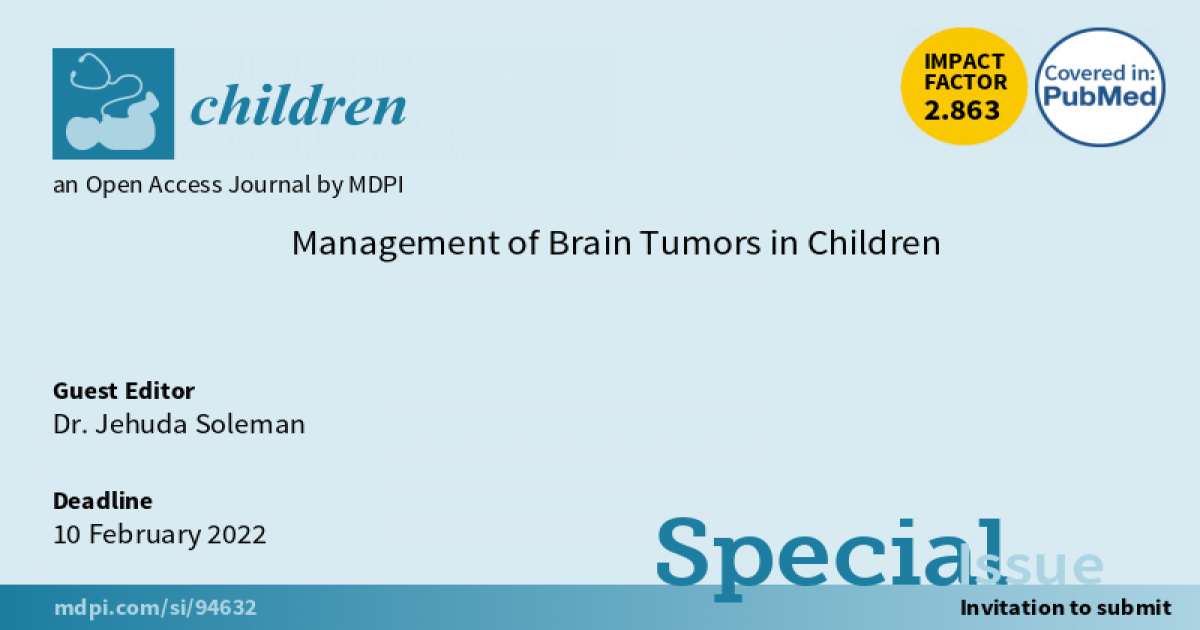Management of Brain Tumors in Children
A special issue of Children (ISSN 2227-9067). This special issue belongs to the section "Pediatric Neurology & Neurodevelopmental Disorders".
Deadline for manuscript submissions: closed (20 September 2022) | Viewed by 52252

Special Issue Editor
Interests: : the management of pediatric brain tumors; neuroendoscopic treatment of cysts and hydrocephalus in children; improvement of operative techniques for craniosynostosis; outcome after surgery for pediatric epilepsy
Special Issue Information
Dear Colleagues,
Pediatric brain tumors are the most common solid tumors in children. They are a source of great concern and anxiety to the children and their parents and caregivers. Fortunately, there have been rapid developments in our understanding and treatment of pediatric brain tumors. Due to the large variety of these lesions, treatment options and approaches often vary greatly and are very much dependent on the type of tumor. Many new and exciting aspects were discovered over the last few years and help in improving the management and treatment of these patients.
The goal of this Special Issue of Children is to highlight recent advances in the management of brain tumors in children, focusing on all of the different aspects, such as the surgical management of different tumor types and locations, differences in the management of children vs. adult brain tumors, postoperative management and rehabilitation in children with brain tumors, complications associated with the management of brain tumors in children, adjuvant and neoadjuvant treatment of brain tumors in children, the effect of molecular diagnosis on the treatment of brain tumors in children, management of pediatric brain tumors in the transitional period to adulthood, management of incidentalomas/incidental low grade tumors in children, and malignant transformation of pediatric brain tumors. We welcome reviews and original research to advance our understanding and bridge any gaps in the treatment of brain tumors in children.
I look forward to receiving your contributions.
Dr. Jehuda Soleman
Guest Editor
Manuscript Submission Information
Manuscripts should be submitted online at www.mdpi.com by registering and logging in to this website. Once you are registered, click here to go to the submission form. Manuscripts can be submitted until the deadline. All submissions that pass pre-check are peer-reviewed. Accepted papers will be published continuously in the journal (as soon as accepted) and will be listed together on the special issue website. Research articles, review articles as well as short communications are invited. For planned papers, a title and short abstract (about 250 words) can be sent to the Editorial Office for assessment.
Submitted manuscripts should not have been published previously, nor be under consideration for publication elsewhere (except conference proceedings papers). All manuscripts are thoroughly refereed through a single-blind peer-review process. A guide for authors and other relevant information for submission of manuscripts is available on the Instructions for Authors page. Children is an international peer-reviewed open access monthly journal published by MDPI.
Please visit the Instructions for Authors page before submitting a manuscript. The Article Processing Charge (APC) for publication in this open access journal is 2400 CHF (Swiss Francs). Submitted papers should be well formatted and use good English. Authors may use MDPI's English editing service prior to publication or during author revisions.
Keywords
- pediatric brain tumors
- pediatric neurosurgery
- management of brain tumors
- molecular diagnosis
- targeted therapy
- neurosurgical treatment
- malignant transformation
- incidentalomas
- low grade tumors
- high grade tumors
Benefits of Publishing in a Special Issue
- Ease of navigation: Grouping papers by topic helps scholars navigate broad scope journals more efficiently.
- Greater discoverability: Special Issues support the reach and impact of scientific research. Articles in Special Issues are more discoverable and cited more frequently.
- Expansion of research network: Special Issues facilitate connections among authors, fostering scientific collaborations.
- External promotion: Articles in Special Issues are often promoted through the journal's social media, increasing their visibility.
- Reprint: MDPI Books provides the opportunity to republish successful Special Issues in book format, both online and in print.
Further information on MDPI's Special Issue policies can be found here.






